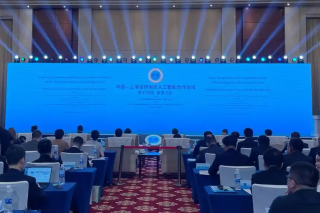Long scroll recalls memories of life in old Tianjin

A section of the scroll shows life in the small town. [Photo/Ninghe District's Archives]
A long scroll called Lutai Street View by artist Tong Zhuocai, who was born in the northern port city of Tianjin's Ninghe district, recalls a street scene before 1949 in its Lutai town.
Lutai town came to existence relying on the Jiyun River, a major north branch of Haihe River and its further development was supported by the extension of the Tangshan-Xugezhuang Railway, the first self-built standard freight railway in China.
At the time, the Jiyun River was busy transporting ships carrying grain, silk, porcelain and tea from the South China to Lutai.
It then sent Ninghe specialty silverfish, purple crab and reed products to Tianjin and Beijing.
Meanwhile, Lutai Railway Station transferred Kailuan coal to Tanggu and sold it all over the world.
It was the river and the railway that lead to the rapid development and prosperity of the area in the late Qing Dynasty (1644-1911).
Lutai town was widely known for "one market, three streets and one dock".

A section of the scroll shows life in the small town. [Photo/Ninghe District's Archives]
The third and eighth day of the Chinese lunar calendar were Lutai town's market days, when merchants from surrounding areas flocked there.
The scroll faithfully depicts the wide variety of colorful goods, as well as the cheers from bystanders taking in performances by folk artists.
In other scenes, customers and crowds thread through to watch, select and taste goods and smell the snacks ranging from fried dumplings, fried shrimps, roast chickens to grilled meat. Vendors, hawking their wares, mingle together.
"Three streets" refers to Lutai's three east-west directed main streets. The south street was mainly used for residential houses. Most of them were tall brick houses with courtyards with floral-pendant gates, screen walls blocking main rooms and wing-rooms.
Three pavilions were notable structures in the middle street. Depicted in the scroll are numerous stores in the street selling cloth, silk, stationery, cakes, musical instruments and more.
The north street was built along the Jiyun River. Dealers of wood, grain, coal, and other goods transported by the river often set up their warehouses here.

Ninghe's nowadays commercial street. [Photo/TJyun]
There was also a long-established white wine store in the street, besides which was located a theatre that staged traditional local opera and other performances.
On the long scroll, people can be seen taking in the majesty of the temples with their high rising flags, which honor the gods and ancestors.
Because Ninghe was rich in sea salt at the time, Lutai also built a unique Salt Mother Temple to bless the prosperity of its salt production.
These days some of temples have been transformed into schools and other public utilities.
Before some of the temples on the scroll, are crowds gathering to watch performances. The town provided many different performances including lion dances and Shaolin martial arts demonstrations.
Moving your eyes along the scroll, the viewer can feel the life of Lutai town back then vividly -- and most importantly, it helps to preserve the culture and memories of a bygone age.

Ninghe district's wetland. [Photo/Xinhua]

Copyright ©
Tianjin Municipal Government. All rights reserved. Presented by China Daily.
京ICP备13028878号-35



